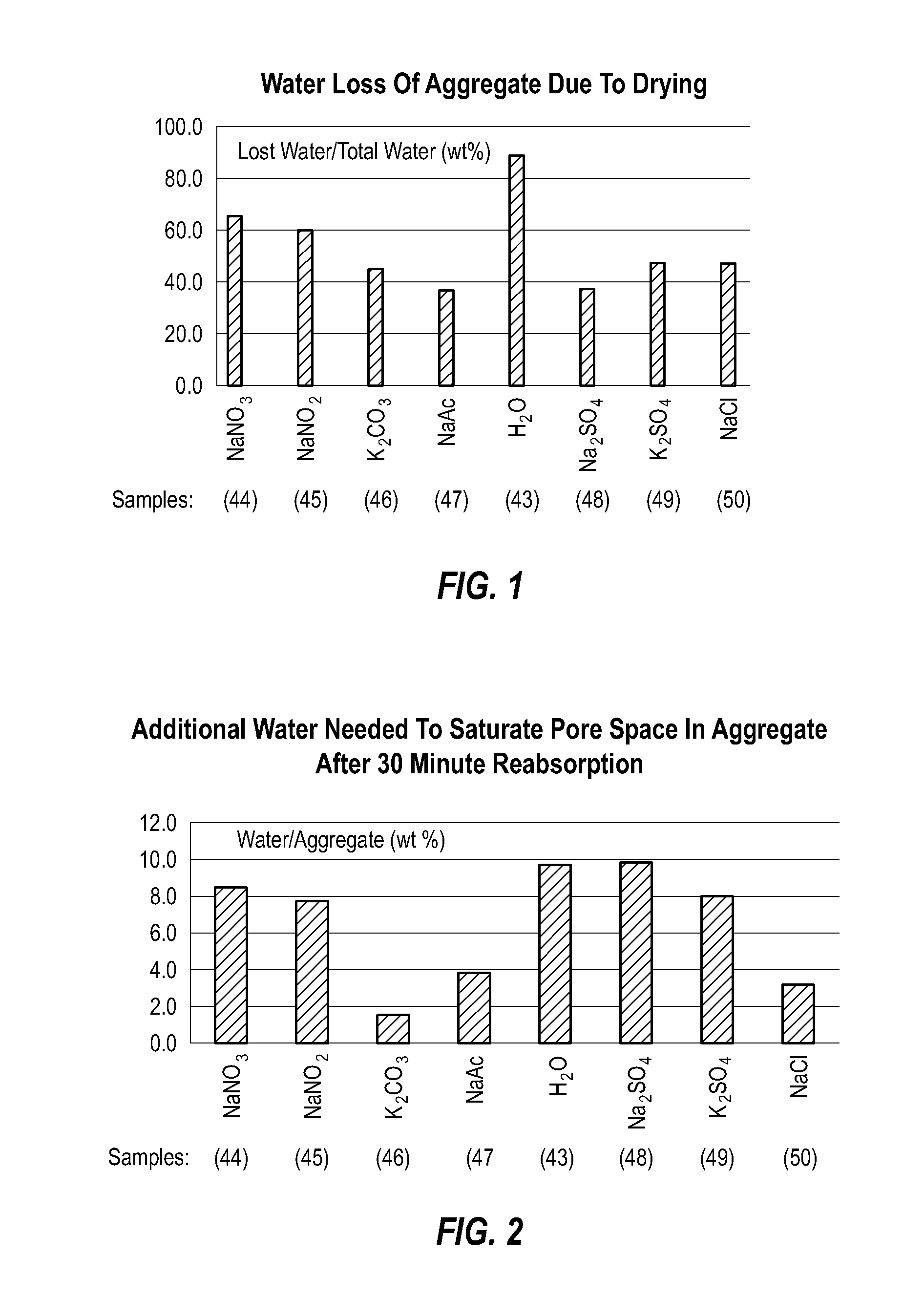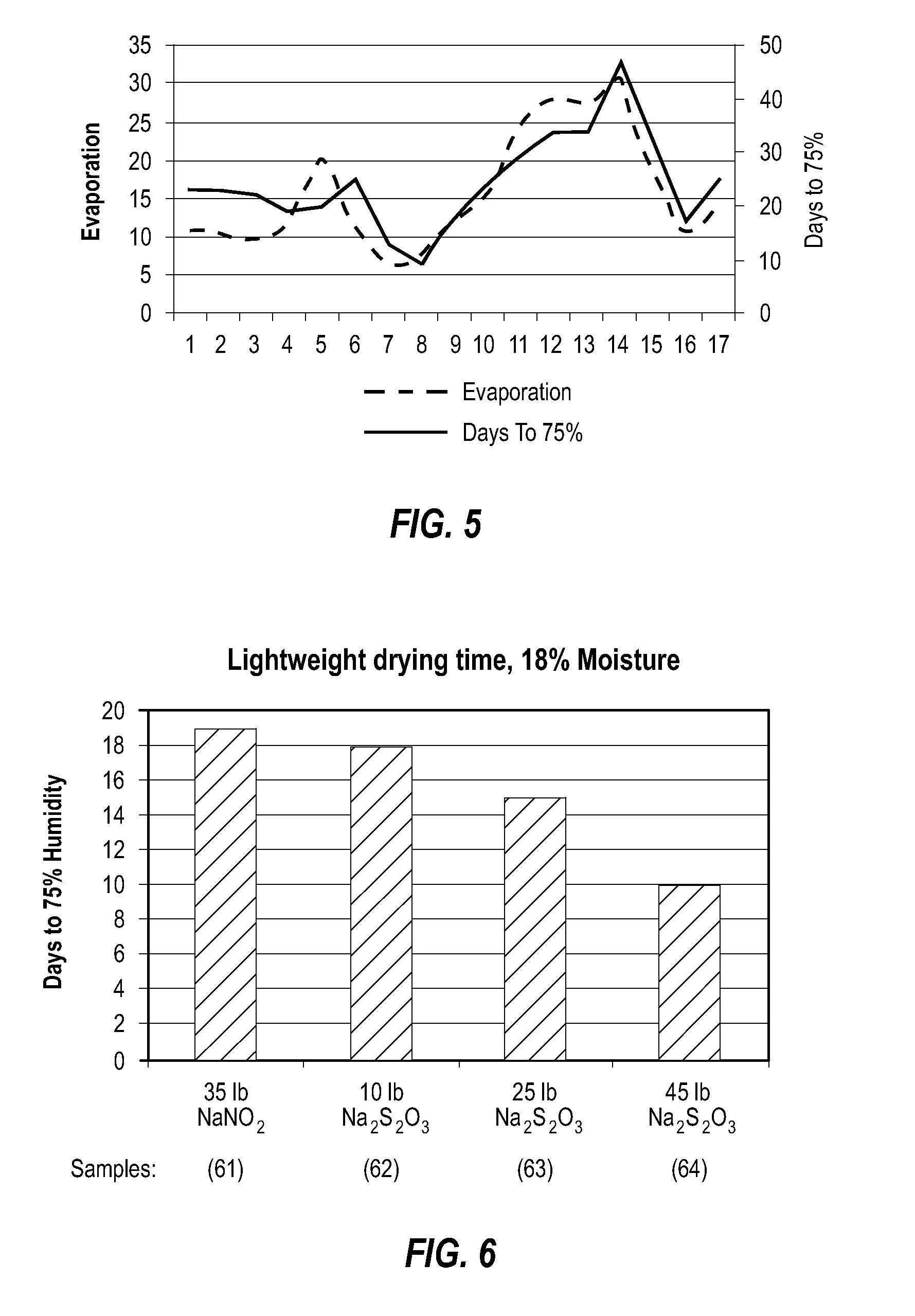Concrete compositions with reduced drying time and methods of manufacturing same
- Summary
- Abstract
- Description
- Claims
- Application Information
AI Technical Summary
Benefits of technology
Problems solved by technology
Method used
Image
Examples
examples 1-2
[0275]The purpose of the tests in Example 1 were to demonstrate the effect of the concentration of a polycarboxylate superplasticizer and the use of a water reducer on the use of chemically bound water and the extent of shrinkage realized by the concrete sample mixes of Table 9.
TABLE 9Sample 1Sample 2Sample 3Compound / PropertyConcrete MixPortland Cement, Type I-II, lb800517611Sand, ASTM C33, lb1,3001,5251,5001 inch Stone, ASTM C33, lb1,8501,8501,850GLENIUM 3000, oz / 100 lb cement16.0—8.0POLYHEED 997, oz / 100 lb cement—5.3—Water, lb225290228water to cement ratio0.280.560.37Air Content, %1.73.45.4Density, lb / ft3 (pcf) 155147148Yield, ft3 / yd326.928.128.1Slump, inches>6.004.255.25
[0276]The data in Table 10 shows the shrinkage results for the concrete mixes of the examples. The specimens were tested according to the ASTM C157 (2006) protocol. Each shrinkage sample was cured at 73° F. and 100% humidity for 24 hours, and followed by a curing step while immersed in water for 7 days. Drying was...
example 3
[0279]The purpose of the tests in Example 3 were to demonstrate the effect of a polycarboxylate superplasticizer on the reduction in the amount of time needed to achieve a desired rate of water vapor emissions using the concrete sample mixes of Table 11.
TABLE 11Sample 4Sample 5Sample 6Compound / PropertyConcrete MixPortland Cement, Type I-II, lb800517611Sand, ASTM C33, lb1,3001,5251,5001 inch Stone, ASTM C33, lb 1,8501,8501,850GLENIUM 3000, oz / 100 lb cement16.0—8.0POLYHEED 997, oz / 100 lb cement5.3Water, lb225281228water to cement ratio0.280.540.37Air Content, %3.4N / A5.6Density, lb / ft3 (pcf)155146147Yield, ft3 / yd327.028.228.2Slump, inches>6.004.505.00
[0280]The curing data and number of days required to achieve a water vapor emission rate of 3 lb / 1000 ft2 / 24 hr shown in Table 12 were obtained by casting each of the samples in a 2 foot×2 foot×5′ / 2 inch deep panel lined with polyethylene. Immediately prior to initial set, each panel was given a steel trowel finish and sealed for the noted...
example 4
[0282]The purpose of the tests in Example 4 were to demonstrate the effect of a polycarboxylate superplasticizer along with the presence of a reactive pozzolan on the amount of time needed to reduce the internal relative humidity to a desired value using the concrete sample mixes of Table 13.
TABLE 13Concrete MixCompound / PropertySample 7Sample 8Sample 9Hanson Cement, Type I-II, lb517740740Silica Fume, lb—60—Metakaolin, lb——60Sand, ASTM C33, lb1,5251,2001,200Sand, ASTM C33 #67, lb1,9501,9501,950GLENIUM 3000, oz / 100 lb cement—16.216.2POLYHEED 997, oz / 100 lb cement5.0——Colloid Defoamer, oz0.50.50.5Water, lb264186197water to cement ratio0.510.230.25Mix Temperature, ° F.656667Air Content, %1.33.61.1Density, lb / ft3 (pcf)152156156Yield, ft3 / yds28.126.526.7Slump, inches5.75flowingflowing
[0283]Each sample was cast in a 2 foot×2 foot×5½ inch deep panel lined with polyethylene. Immediately prior to initial set, each panel was given a steel trowel finish and sealed for a 13-day cure period at 73...
PUM
| Property | Measurement | Unit |
|---|---|---|
| Fraction | aaaaa | aaaaa |
| Fraction | aaaaa | aaaaa |
| Fraction | aaaaa | aaaaa |
Abstract
Description
Claims
Application Information
 Login to View More
Login to View More - R&D
- Intellectual Property
- Life Sciences
- Materials
- Tech Scout
- Unparalleled Data Quality
- Higher Quality Content
- 60% Fewer Hallucinations
Browse by: Latest US Patents, China's latest patents, Technical Efficacy Thesaurus, Application Domain, Technology Topic, Popular Technical Reports.
© 2025 PatSnap. All rights reserved.Legal|Privacy policy|Modern Slavery Act Transparency Statement|Sitemap|About US| Contact US: help@patsnap.com



